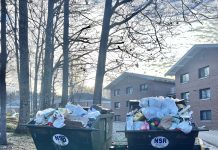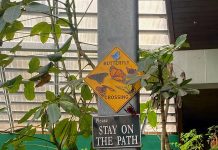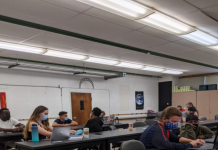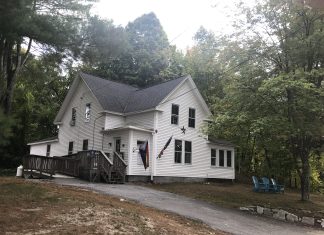Multiple sources are driving a change here at NEC, including students and faculty. Stephanie Goulet, President of the Environmental Action Committee (EAC), and Adam O’Reilly, a member of, along with faculty, like Part-time Professor Jodi Adams, Professor Mark Mitch, William Homestead, and Part-time Adjunct Professor Richard Doherty, are each making a difference by getting involved.
The coming results of such efforts: a brand new recycling process on campus.
To talk about this and more, EAC, with Goulet and Mitch, Professor of Environmental Science took the lead in a Sustainability Task Force Meeting held on September 28th in the Sayce Lounge.
Advised by Mitch since 2008, this student-run club raises awareness and holds events regarding campus sustainability and will take the lead on the education component of the new program. This leaves the facility to do their part in removal. New containers are set to be in place sometime this year though, as of yet, the exact staffing requirements haven’t been determined in regard to coordinating on-campus pick-up and delivery.
Mitch, who’s been with NEC 19 years, said, “We have a very firm commitment from facilities, in having enough recycling containers and people to maintain those containers.”
After NEC experienced a period of restructuring three years ago, they’re now tracking how well things are working, so Mitch used the phoenix analogy that the recycling system was ‘rising from the ashes.’
“The big initiatives in tracking energy consumptions began in 2009-2010,” Mitch explained. “There was a big push to go green.”
It was right after NEC submitted a proposal for funding to support renewable energy on campus (prior to that, the college had yet to examine energy consumption). Around the same time, the Environmental Sustainability Major was created (now fused into the Environmental Studies Major).
Mitch is a teacher in the subject, but he’s also interested in sustainability from the ethical perspective, begging the question, “What are our obligations to the environment?”
He said, “I see a lot of students who don’t think twice about throwing away a recyclable can,” which is why EAC’s component to this plan’s so important.
Historically, the cost of solid waste removal at NEC’s been around $50,000 a year. Even since they started recycling, which reduced refuse dumpsters, the price hasn’t shifted. Though there are different models of recycling processes, and the ones involving the separation of material generally bring in a profit and those providing one container for all don’t, as nice as it would be to turn trash to cash, EAC would be happy to get students to recycle at all. They’ve decided to settle for this method, as it seems works on a greater scale.
As November 15th is ‘America Recycles Day,’ Goulet suggested NEC commemorate the new program with an event, though the change in systems may not be in place so soon despite her hope that it would be. Mitch explained that getting staff shifted mid-semester was difficult, especially as NEC’s up for accreditation and about to complete their five-year report so will be going through an extensive review process. This was why the exact date and ‘how’ the new recycling receptacles would be installed remained tentative in spite of efforts to pin a date down.
On EAC’s agenda for the future was also an on-campus reduction of carbon emissions. The group had already been looking at past electric and heating bills and entering the data into a software program that isolated patterns, which showed that while some buildings remained remarkably stable (which is good), others oscillated with the differences being up to $30,000 per year. Mitch said that was partially due to changing oil and petroleum prices and the severity of weather conditions, but the greatest variable was how many windows are left open. But there was still a lot of work to be done in calculating these numbers, as the data was originally recorded separately.
“Once we have our footprint tied down, so we know what we’re doing, we have to look at our carbon emissions footprint,” Mitch said.
Five buildings at NEC have solar-powered hot water Mitch explained, but one of the systems isn’t functional. One of the ways to track how “green” a building is, LEED Certification (which follows a long list of criteria leading to labels like gold, silver, or bronze based on the number of specifications met), is not a path NEC has yet traveled down, but the new John Lyons Center is the equivalent. This means it functions as if LEED-Certified minus the costs of inspection. According to Mitch, the new auditorium will also be built to LEED Certified standards.
The company who built the Lyons Center was supposed to generate a report regarding the percentage of excess materials that were recycled, and EAC plans to follow-up with them so they can keep track of the actual numbers.
“It’s kind of important for us to poke around and ask these questions,” said Professor of Communication Studies William Homestead.
EAC hopes to spark involvement from students, faculty, and staff, who are encouraged to visit one of the meetings they hold on Wednesdays at 4pm, and each contribution made increases the likelihood EAC make its vision of lessening NEC’s footprint into a reality.




















